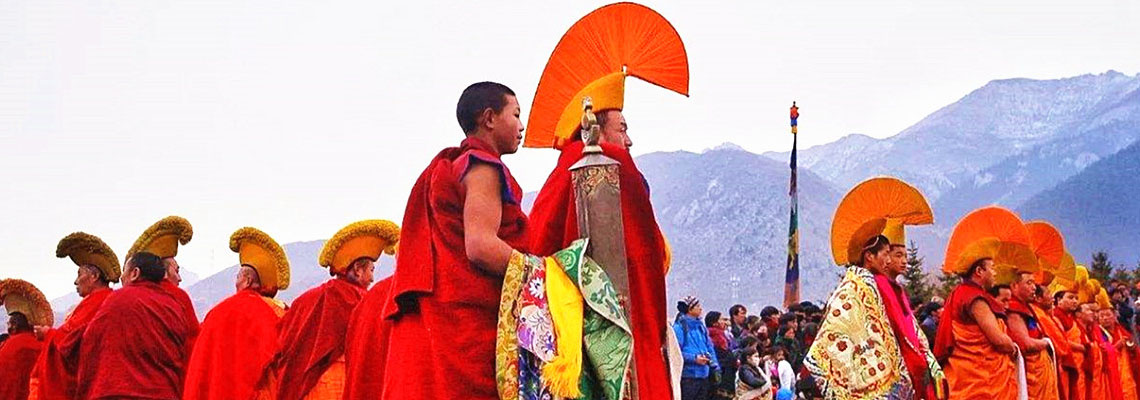
Day 1
BeijingYou will arrange for your own international flight to arrive in Beijing. We will meet you at the airport, transfer you to the hotel and have you checked in. You should have the rest of the day free to do a little exploration at your leisure.
Day 2
Beijing-
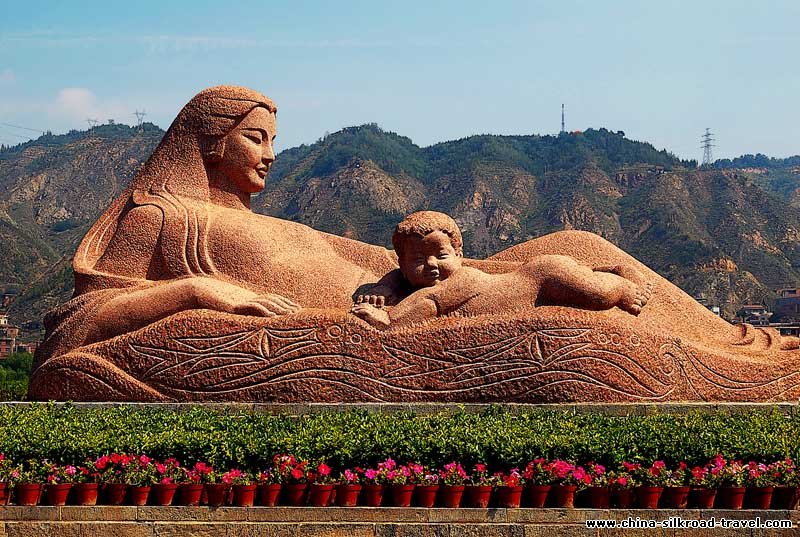
- Yellow River Mother Sculpture
We will send you to the airport to take the morning flight to Lanzhou. Upon your arrival in Lanzhou, we will transfer you to the hotel and check you in. We will then take the city tour, visiting the Yellow River Mother Sculpture, and Water Wheel Park.
Yellow River Mother Sculpture: The Yellow River is revered by the Chinese as the mother of their civilization. It runs right through Lanzhou, the capital of Gansu Province. The Yellow River Mother Sculpture is located on the south bank of Yellow River in the city of Lanzhou. The sculpture is 6 meters long and 2.6 meters in height, and weighs more than 40 tons. The sculpture comprises a mother and a baby, the mother with long hair, slim figure, lying on the undulating water looking happy and kind. Resting on her breast is a small child smiling naively. The Yellow River Mother Sculpture reflects the long history and culture of Gansu Province.
The Waterwheel Garden: The Waterwheel Garden was built in 1994, and is located on Binhe Middle Road in Lanzhou, Gansu Province. The garden covers an area of 1.45 hectares (3.58 acres) and is comprised of two waterwheels, a cofferdam, the recreation area and a water mill house.
Day 3
Lanzhou-
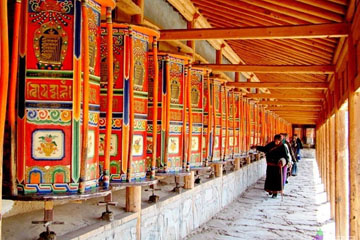
- Labrang Monastery
We start the day early to enjoy the scenic drive to Xiahe on the Qinghai Plateau. This less-frequented route we take is dotted with quaint and pretty Hui (Muslim) and Tibetan farms and villages. The rolling high altitude grasslands with flocks of yaks and sheep are especially pretty. We will visit Labrang Monastery that is reputed to be more Tibetan than Tibet itself. We'll have adequate time just walking around and taking in the atmosphere.
Labrang Monastery: The Labrang Monastery is located at the foot of the Phoenix Mountain, northwest of Xiahe County in Gannan Tibetan Nationality Autonomous Prefecture, Gansu Province. As a propitious place in the hearts of the Tibetans, it stands by the Daxia River and faces the Dragon Mountain. A long time ago, this place was a boundless sea, which over time had turned into the present landscape. There is a beautiful legend that tells about how the Dragon Mountain, Phoenix Mountain, and the Daxia River were formed.
Day 4
Xiahe-
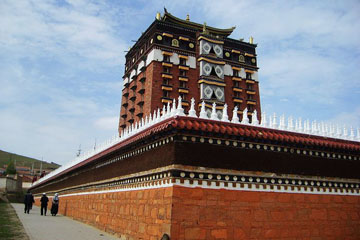
- Milariba Buddhist Pavilion
On the drive to Langmusi, a small alpine town at the border of Gansu and Sichuan provinces, there are two Tibetan monasteries, one called Sezhi monastery in Sichuan Province and the other called Geerdeng Monastery in Gansu Province. Locals simply call them Sichuan Monastery and Gansu Monastery. Both are majestic temples with red walls and golden roofs built on the high slopes, overlooking hundreds of white-painted monks' houses. We will visit the Milariba Buddhist Pavilion at Hezuo County.
Milariba Buddhist Pavilion: This is the only building of its kind in the region. It is surrounded by formidable guardian walls on the outside, which feature white towers displaying the classic Buddhist style.
Day 5
Langmusi-
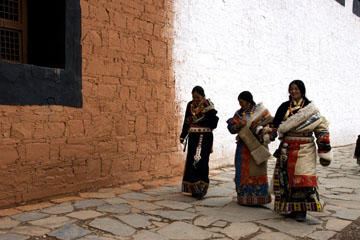
- Langmusi
We have a full day visiting the two Tibetan monasteries, and wander about the pretty villages. There are numerous trekking possibilities and we have the services of local Tibetans to take the group around this very un-touristy area of Gansu.
This small alpine town Langmusi is known as the tiger cave and the fairy in Tibetan. It was said that there was a fierce tiger in the cave of the canyon on the southeastern bank of Bailong River. And there was also a stalactite which is the spitting image of a slim fairy. So it is said there is a fairy in the tiger cave. However, another story was going about that a beautiful girl who was kind, selfless and brave who turned into a rock in the cave with the company of the tiger in order to prevent the tiger from doing harm to people. There are lots of Buddhist ceremonies in Tibetan. The main Buddhist ceremonies at Langmu Temple are the sunning of the Buddha Festival and Living Buddhas’ teaching. Buddhist Tangka, shaidafo is a routine Buddhist ceremony which is held on the 15th of the first month in the lunar calendar, the Lantern Festival every year.
Day 6
Langmusi-
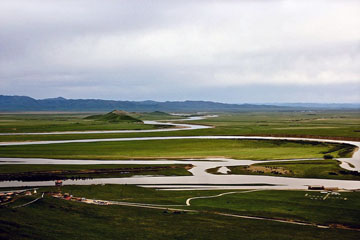
- First Bend of the Yellow River
After breakfast, we will drive to visit the First Bend of the Yellow River. The 80km road from Langmusi to this First Bend is in poor condition and takes about 3 hours of hard driving. From here it is another 4 hours to Zoige.
First Bend of the Yellow River: This is about 65km west of Zoige (Ruoergai). It is worth visiting. The river coming from west turns northward around Tangke, flowing through a wonderful landscape of wild flowers and meadows. The clear blue sky, the silver-belt like stream, the green grassland with wild flowers dotted here and there and the herds of sheep, yaks compose a nomadic song with the pleasant melody.
Day 7
Ruoergai-
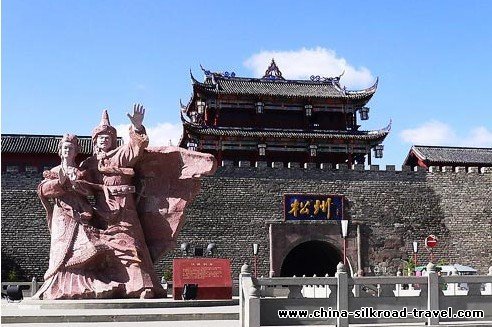
- Songpan Ancient Town
Today we will drive to Songpan. On the way we will pass the grassland where the Red Army walked through during the Long March. After lunch, we will visit the Ancient Songpan Town and take a walk in the city.
Songpan Ancient Town is located in the northwest of Sichuan Province. It was an important frontier city, a vital strategic point, and an important economic center of northwestern Sichuan Province. At present, it is the cruising hub of Jiuzhaigou Valley, Huanglong, Hongyuan, Rouergai Grassland and other important scenic spots. Songpan Ancient County which always been called the “ancient city on the plateau” is one of the State Protected Historic Sites. Songpan County is also known as Datang Songzhou city. It was built in the Tang Dynasty (618–907) and was named after the towering pines in the city. Historical traces can be easily found in the present layout of city: the ancient city with blue city walls; the low buildings and the numerous lanes in the city; four broad main streets (East Street, West Street, South Street and North Street) orderly scattering in the city; ancient bridges with long history; the flowing rivers under the bridges; the tea houses and cane chairs near the river; the tall city gates and the green hills outside the city etc. Everything in the field of vision gives people a sense of going back to the ancient times.
Day 8
Songpan-
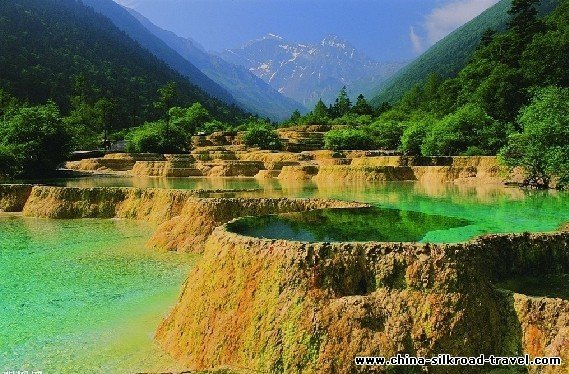
- Huanglong Scenic
After breakfast we will head to Huanglong and visit the Huanglong Scenic and Historic Interest Area.
Huanglong Scenic and Historic Interest Area: Huanglong is located on the easternmost of Qinghai-Tibet Plateau. It belongs to Songpan county, an Aba Tibetan and Qiang autonomous prefecture in Sichuan province. It is 300 kilometers from Chengdu, the capital of Sichuan. Jiuzhaigou Valley is as its neighbor. It is close to the boundary of provinces of Sichuan, Gansu, and Shanxi. The whole area looks like a golden dragon looking from above. That is the reason why the place is called Huanglong, a yellow dragon in Chinese. The main area consists of Huanglong Valley, Danyun Valley, Red-star Cave, Xuebaoding, Mouni Valley, and Songpan Ancient City. The total area occupies 1340 square kilometers. It is famous for “the colorful ponds, the beaches, the snow-capped peaks, the valleys, the ancient temple, and the folk customs”. Huanglong Scenic and Historic Interest Area is often known as “the paradise on earth.
Day 9
Huanglong-
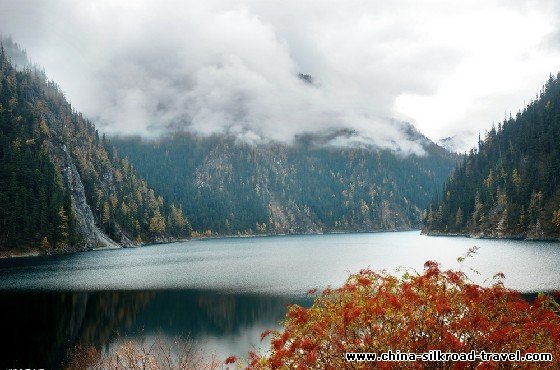
- Jiuzhai Valley National Park
In the morning we will head to Jiuzhaigou, to explore and enjoy the Jiuzhai Valley National Park.
Jiuzhaigou Valley National Park: Jiuzhaigou is a scenic area of outstanding beauty in southwest China’s Sichuan province. The World Heritage-listed spot is situated about 400 kilometers north of the province’s capital city, Chengdu, and is over 80 kilometers long, covering an area of 60,000 hectares. ‘Jiuzhaigou’ means ‘Nine Village Valley’ and refers to the nine villages of Tibetan people here. The spot was discovered by some woodcutters in the 1970s and was so admired over the next few years that it was listed as one of the most important scenic spots in China in 1982. By 1992 Jiuzhaigou had become one of China’s 33 World Heritage sites, including E’Mei Mountain and Huangshan Mountain.
Day 10
JiuzhaigouDay 11
Jiayuguan-
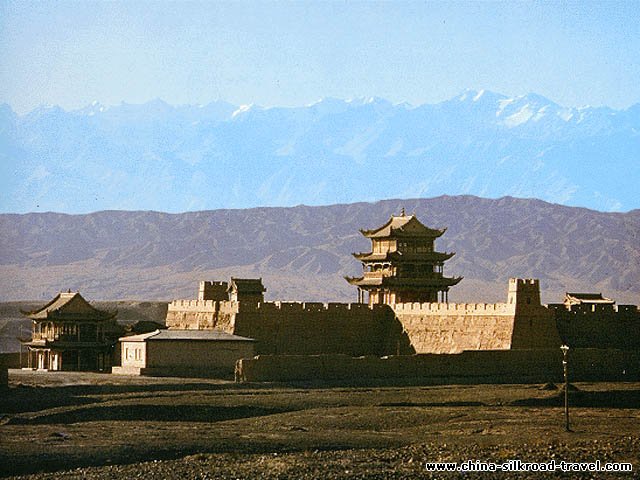
- The Jiayuguan Pass
In the morning we will visit The Jiayuguan Pass, The Great Wall on the Cliff, Great Walls Museum and Yulin Grattoes. After that we will head to Dunhuang.
Jiayuguan Pass: Jiayuguan Pass stands in the southwest part of Jiayuguan City, about 6 km away from downtown. The Ming Dynasty fort here guards the strategic pass, at the western end of the Great Wall – this was the last section built by the Ming Dynasty. Construction of the fort was started in 1372 in the Ming Dynasty, and subsequently enlarged and strengthened, and was known as 'the strongest pass under heaven'. It is located in the Jiayu Highland, hence its name Jiayuguan. It is situated between the Wenshu and Heishan Mountains at the foot of Jiayuguan Hill of the Qilian Mountain range.
The Great Wall on the Cliff: The Suspended Wall is a part of the Great Wall of China. The wall here was built on the ridge with a gradient of 45 degrees. It is high in the air and it looks as if it fell down from the top of the hill. So people refer to this section of the Great Wall as the "Suspended Wall". The Suspended Wall, the extension of the walls at the Jiayuguan Pass towards the north, was an integral part of the ancient defense system at the Jiayuguan Pass.
Great Wall Museum: The Great Wall museum opened to visitors in October 1989, and it is the first museum to exhibit the Great Wall culture in a comprehensive and systematic way. The Museum covers an area of 12,312 square meters with an exhibition area of about 1,766 square meters. Its main building takes a shape of a typical signal fire tower on the Great Wall.
Yulin Grottoes: The Yulin Grottoes lie 70 km to the south of Anxi County, Gansu Province. The Grottoes are chiseled into the cliffs on both the east and west sides of the Yulin River. The east cliff has 30 grottoes and the west has 11, with a distance of more than 100 meters between them. It used to be called Ten-Thousand Buddha Gorge. The grottoes began to be chiseled and sculpted during the Northern Wei Dynasty (386-534), and was enlarged in the later dynasties, such as Tang (618-907), Five Dynasties (907-960), Song (960-1279), the Western Xia (1038-1227), Yuan (1271-1368) and so on. More than 1,000 square meters of frescoes, and more than 100 colored sculptures are still extant there. The name Yulin (elm forest) came from the elms in the valley, and as you travel along the valley road you can easily imagine how it must have been to be a poet or brave solder in the distant past.
Day 12
Dunhuang-
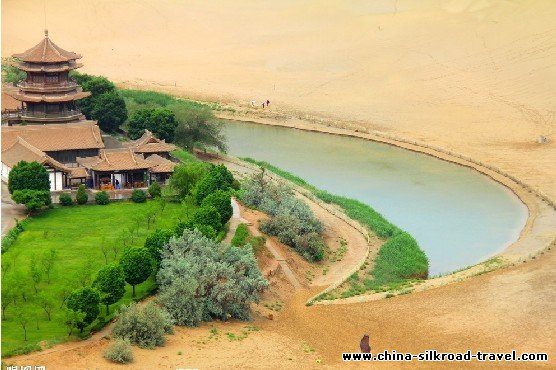
- Echoing-Sand Mountain
After breakfast we will visit the Mogao Grottoes, Echoing-Sand Mountain and Crescent Lake. Then you will be transferred to the railway station to catch the train to Turpan.
Mogao Grottoes: The Mogao Grottoes, a shrine of Buddhist art treasures, is 25 km from downtown Dunhuang on the eastern slope of Mingsha Shan (Echoing Sand Mountain). A network of plank-reinforced roads plying north to south 1600 meters long lead to the cave openings, which are stacked five stories high, some reaching up to 50 meters. Incidentally, Mogao means high up in the desert. According to Tang Dynasty records, a monk had witnessed onsite a vision of thousand Buddhas under showers of golden rays. Thus inspired, he started the caves construction work that spanned a millennium, from the 4th to the 14th centuries. What remains today is truly awe inspiring, and is likely the world’s richest treasure house of Buddhist sutras, murals and sculptures. Please note that cameras are not allowed inside the grottoes.
Echoing-Sand Mountain and Crescent Lake: Together with the Crescent Spring and the Mogao Caves, the Echoing-Sand Mountain is the most popular tourist site in Dunhuang. Echoing-Sand Mountain, known as Mingsha Mountain to the Chinese, is 5 km to the south of Dunhuang and is famous for the constant sound of the moving sand. Legend has it that many years ago a horrific battle was fought here, and the sounds we hear today were the haunting cries of soldiers buried in the sand dunes. Situated within the Echoing-Sand Mountain Park, the Crescent Moon Lake is literally an oasis in the desert. The lake’s name derives from the crescent moon shape taken by the pool of spring water between two large sand dunes. Although the surrounding area is very dry, the pool surprisingly doesn’t dry up as one might expect.
Day 13
Turpan-
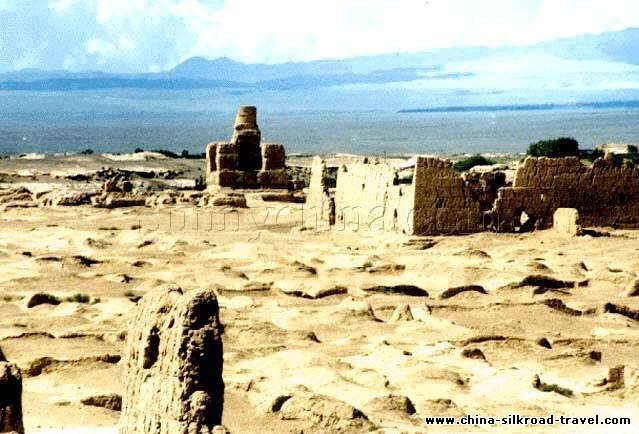
- Jiaohe Ruins
After checking into the hotel in Turpan, we will visit Jiaohe Ancient City, Astana Tombs, Tuyoq Valley and The Flaming Mountain.
Jiaohe Ancient City Ruins: The city's name means 'River City'. It was founded during the first century BC and abandoned during the 15th century. It is located atop a steep cliff on a leaf-shaped plateau between two deep river valleys in the Yarnaz valley 10 km to the west of Turpan City. It runs northwest to southeast, 1760 meters long and 300 meters across at the widest part. The ruins include city gates, streets and lanes, government office, temples, domestic houses, cave houses, wells, and an underground temple. It is part of the UNESCO World Heritage Silk Road Sites.
Astana Tombs: This is the graveyard of the residents who lived in the Gaochang City in the Jin-Tang period. Between 1959 and 1975, a great number of cultural relics had been unearthed, including Chinese documents, textiles, epitaphs, coins, clay sculptures, pottery, wooden wares, silk-paintings, crops and foods, etc. The site is known as the Underground Museum.
Tuyoq Valley: This is a 12 km long primitive Uighur agricultural valley about 70 km from Turpan, with vineyards and fields in the northern and southern valleys and a narrow ravine that connects them. It is a Muslim religious pilgrimage site. The southern mouth of the valley has big Uighur mosques older than the Sugong Minaret and a cave thought by many to be described in the Koran. About a kilometer from the cave shrine is a group of grottoes that have some Buddhist and Nestorian artwork. These grottoes are said to date from the West Jin Dynasty (265AD-316AD), and are considered to be the earliest in Turpan. Most of the murals are damaged. Fortunately, 10 of the grottoes still have some of the preserved murals. These precious murals are very unique in style.
The Flaming Mountain: The Flaming Mountain is famously described in the classic Chinese mythological novel “Journey to the West”. It runs west from Shanshan County, is 98 km in length and 9 km across, with a relative height of 500 meters and the highest peak at 832 meters. The mountain is a branch range of the Bogda Mountain, formed in the orogenic movements of the Himalayas. This is the hottest place in China. The highest air temperature in summer is 47.8 degrees Centigrade, and the ground is over 70 degrees Centigrade in summer. Many years of volcanic activity have formed the unique crisscrossing gullies and ravines. During mid-afternoon the heat becomes intense as the sun's rays are reflected off the red rocks, as though the hillsides are engulfed by tongues of fire, hence the name.
Day 14
Turpan-
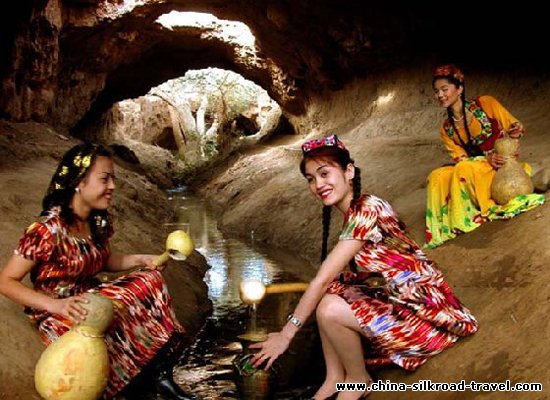
- Karez Irrigation System
After breakfast we will visit the ancient Karez Irrigation System, Sugong Minaret, and then return to Urumqi to take the flight to Kashgar. We will check into the hotel upon arrival in Kashgar.
Karez Irrigation System: The ancient Karez Irrigation System, which is still used today, is a unique irrigation system in Turpan. It takes advantage of the slopes, draws the underground water to flow by itself to irrigate farmland. It consists of four parts: vertical wells, underground channels, ground canals, and small reservoirs.
Sugong Minaret: Located in Mura Village 2km to the east of the city of Turpan, the minaret tower was built in the 41st year of the long reign of Qianlong Emperor during the Qing Dynasty. It is the embodiment of the ancient architectural arts of the Uighur people. The body of the tower is cylindroid in shape, built with bricks arranged in various symmetrical patterns on the outer wall. The tower has 14 windows and a spiral staircase inside going to the top.
Day 15
Kashgar-
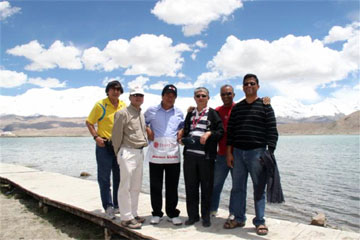
- Karakul Lake
After breakfast we will visit the Sunday Bazaar, and then head to Karakul Lake to enjoy the beautiful scenery.
Karakul Lake: At an altitude of 3600m, this is the highest lake of the Pamir plateau, near the junction of the Pamir, Tianshan (Heavenly Mountain), and Kunlun Mountain ranges. Surrounded by mountains which remain snow-covered throughout the year, the three highest peaks visible from the lake are the Muztag Ata (7546m), Konur Tagh (7649m) and Kongur Tiube (7530m). The lake is popular among travelers for its beautiful scenery and the clarity of its reflection in the water, whose color ranges from a dark green to azure and light blue. There are two Kirgiz settlements along the shore of Karakul Lake, a number of yurts about 1 km east of the bus drop-off point and a village with stone houses located on the western shores.
Day 16
Kashgar-
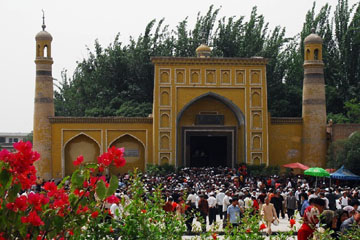
- Id Kah Mosque
In the morning we will visit the Id Kah Mosque, Apak Hoja Tomb, Handcraft Street and the Old town.
Id Kah Mosque: This is the largest mosque in China, and the most famous mosque in Xinjiang. The construction of the mosque started in the middle of the 15th century, and the mosque has gradually developed to its present size. The buildings of Id Kah Mosque look magnificent and solemn, and display the artistic styles of Islamic mosque architecture. The Mosque has an area of about 16,800 square meters, consisting of the Pray Hall, the Koran teaching Hall, the Corridor, the Arches and other buildings attaching to it. The Pray Hall of the mosque, which can hold 4,000 prayers, is supported by 140 carved wooden pillars.
Apakh Hoja Tomb: This Mazar is the holiest place in Xinjiang for the Muslims, and an architectural treasure. Built in 1640, it is reminiscent of the Central Asian artistic style of Samarkand or Isfahan. The site is also known as the Xiang Fei (Fragrant Concubine) Tomb in memory of Abakh Khoja's granddaughter, Iparhan, who was the Fragrant Concubine of Emperor Qianlong of Qing Dynasty. A handsome blue-and-white tiled gate leads into the compound, which includes a small religious school and the Abakh Khoja family tomb. The latter is domed and faced with muti-color tiles. It is the most complete Islamic tomb dating from the beginning of the Qing Dynasty.
Old Town: Kashgar is an ancient city, and in walking the streets of its Old Town, one gets the sense of what this legendary Central Asian hub was like in the days when the Silk Road was at its zenith. 500-year old remnants of the city wall, narrow lanes and colorful multi-ethnic crowds combine to make Kashgar’s historic district a highlight of any visit to the city. Visit the small alleys to look at the characteristic Uygur residences. You will experience and enjoy the culture and history that has been retained in the small alleys and deep courtyards. In the alleys on platforms beside the residence you could marvel at the even more ancient primitive workshops for hand-made earthenware. Some 17 or 18 antique workshops have been restored.
Day 17
KashgarAfter breakfast we will check out from the hotel. We will transfer you to the airport to take the flight to your destination.
| Travel in party of |
Superior Class ★★★★★ |
Deluxe Class ★★★★ |
Tourist Class ★★★ |
| 2-5 persons | N | $ | $ |
| 6-9 persons | N | $ | $ |
| 10 persons & above | N | $ | $ |
| Single room Supplement | N | $ | $ |
Service included:
√ Breakfast in the hotel
√ Personal Guide & Driver + Private car / van for Private Transfers & sightseeing
√ Hotels (twin share bases) as listed in the itinerary .
√ Domestic flights or trains as listed in the itinerary
Train (soft sleeper): Lanzhou to Jiayuguan, Dunhuang to Turpan
Flights with tax: Beijing to Lanzhou , Urumqi to Kashgar
√ Service Charge & Government Taxes .
√ Luggage Transfers between airports and hotels
√ Government letter for visa support
Service excluded:
* Personal expenses. such as laudentry and tips to the guide and driver
* other activities such as boating, camel riding ect

